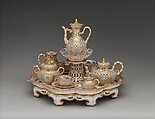Coffee and tea service (déjeuner chinois réticulé)
Manufactory Sèvres Manufactory French
Designer Hyacinthe Régnier French
The various shapes employed for this exuberant service evoke both China and the Near East-the origins of tea and coffee, respectively. The Sèvres factory described the service as a déjeuner chinois reticulé, or a Chinese service with openwork decoration, but its fidelity to Chinese models is slight. The shape of the tray, with its scrolling feet, is based on Chinese lacquerware, and the double-walled forms with openwork exteriors appear to have been inspired by Chinese porcelains sold in Paris in 1826. Additional Chinese-inspired elements include the simulated bamboo handles and the painted Chinese emblems, but the profusion of decorative motifs and the color scheme of white, pink, and gold are entirely European in character. This blending of Asian forms with European decoration reflected the taste for exoticism in mid-nineteenth-century France.
It is not clear if services of this design were intended for display or use, but several were given as diplomatic gifts by Queen Marie-Amélie, who purchased at least seven examples between 1835 and 1843. The double-walled, openwork construction was very difficult to produce, and the factory's obvious success demonstrated its considerable technical expertise.
Due to rights restrictions, this image cannot be enlarged, viewed at full screen, or downloaded.

